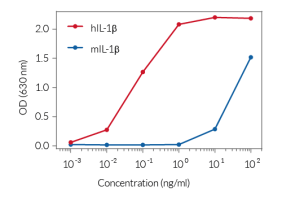BAY 11-7082
-
Cat.code:
tlrl-b82
- Documents
ABOUT
NF-κB inhibitor - NLRP3 inhibitor
BAY 11-7082 was first described as an irreversible inhibitor of the NF-κB pathway [1]. A number of reports have since shown that BAY 11-7082 has multiple targets, including the NLRP3 (NOD-like receptor pyrin domain-containing protein 3, cryopyrin, or NALP3) inflammasome sensor [2]. The multiprotein NLRP3 inflammasome complex is a key player in innate immunity.
Modes of action:
Inhibition of NF-κB translocation into the nucleus:BAY11-7082 inhibits the phosphorylation of IκB-α, which is essential for the release of NF-κB from the cytosolic IκB-α/ NF-κB complex [1]. The transcription factor NF-κB regulates multiple aspects of innate and adaptive immune functions and serves as a pivotal mediator of inflammatory responses.
Inhibition of inflammasome responses: BAY 11-7082 may inhibit the inflammasome responses indirectly by preventing the nuclear translocation of NF-κB at the priming step. Moreover, BAY 11-7082 has been shown to exhibit direct inhibitory functions on the NLRP3 inflammasome by blocking the sensor's ATPase activity [2].
Key features:
- Potent inhibitor of NF-κB and the NLRP3 inflammasome
- Does not inhibit the NLRP1 inflammasome
- InvitroFit™ grade: each lot is highly pure (≥95%) and functionally tested
![]() Read our review on the NLRP3 inflammasome.
Read our review on the NLRP3 inflammasome.
References
1. Pierce JW. et al., 1997. Novel Inhibitors of Cytokine-induced Ikappa Balpha Phosphorylation and Endothelial Cell Adhesion Molecule Expression Show Anti-inflammatory Effects in Vivo.J. Biol. Chem., 272: 21096.
2. Juliana C. et al, 2010. Anti-inflammatory Compounds Parthenolide and Bay11-7082 Are Direct Inhibitors of the Inflammasome. J. Biol Chem. 285(13): 9792–9802.
All products are for research use only, and not for human or veterinary use.
InvitroFit™
InvitroFit™ is a high-quality standard specifically adapted for in vitro studies of inhibitors. InvitroFit™ products are highly pure (≥95%) and guaranteed free of bacterial contamination, as confirmed using HEK Blue™ TLR2 and HEK Blue™ TLR4 cellular assays. Each lot is rigorously tested for functional activity using validated (or proprietary) cellular models. This grade ensures reliability and reproducibility for your research applications.
SPECIFICATIONS
Specifications
C10H9NO2S
25 mg/ml in DMSO, 15 mg/ml in ethanol
1-10 μM for cell culture assays
Negative (tested using EndotoxDetect™ assay)
In vitro Inflammasome cellular assays
Each lot is functionally tested and validated using cellular assays.
CONTENTS
Contents
-
Product:BAY 11-7082
-
Cat code:tlrl-b82
-
Quantity:10 mg
Shipping & Storage
- Shipping method: Room temperature
- -20°C
- Avoid repeated freeze-thaw cycles
Storage:
Caution:
Details
The NLRP3 Inflammasome:
The NLRP3 inflammasome is an innate immune sensor that is activated by a two-step process; a first signal (‘priming’) provided mainly by bacterial components or endogenous cytokines involves NF-κB induction, while the second signal provided by a wide array of stimuli including microbial toxins, endogenous molecules or crystalline substances and leads to inflammasome assembly and activation [1, 2]. This triggers inflammasome multimerization and caspase-1 activation with the subsequent cleavage of interleukin-1β (IL-1β)/IL-18 and the pore-forming protein Gasdermin D (GSDMD) into their active forms. Additionally, the activation of the inflammasome also leads to alarmin secretion and pyroptosis, a form of immunogenic cell death.
1. Swanson K.V. et al., 2019. The NLRP3 inflammasome: molecular activation and regulation to therapeutics. Nat. Rev. Immunol. 19:477.
2. Groslambert M. & Py B. 2018. Spotlight on the NLRP3 inflammasome pathway. J. Inflamm. Res. 11:359.
Chemical structure of Bay 11-7082:

DOCUMENTS
Documents
Technical Data Sheet
Safety Data Sheet
Validation Data Sheet
Certificate of analysis
Need a CoA ?





